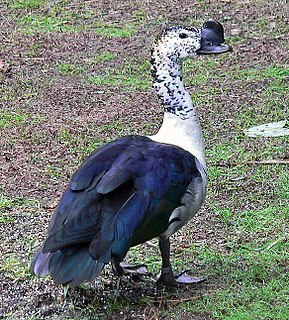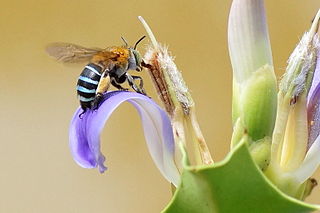
Sarkidiornis is a genus within the family Anatidae. Sarkidiornis is sometimes considered a monotypic genus with its sole member the knob-billed duck, a cosmopolitan species. Most taxonomic authorities, however, split the species into two:

Metzgeriaceae is a family of thallose liverworts in the order Metzgeriales. Species may be either monoicous or dioicous.

Amegilla is a large genus of bees in the tribe Anthophorini. Several species have blue metallic bands on the abdomen, and are referred to as "blue-banded bees". The genus occurs all around the world but very few live above 45° North.

The Hemiphractidae are a family of frogs from South and Central America. Previously, this group had been classified as a subfamily (Hemiphractinae) under family Hylidae. More recent research classifies these genera into their own family, or sometimes into three separate families: Amphignathodontidae, Cryptobatrachidae, and Hemiphractidae (Hemiphractus). An active question still exists as to which of these groupings is more accurate.
The New Ireland forest rat is a large rodent in the family Muridae. It is endemic to New Ireland, in the Bismarck Archipelago, Papua New Guinea.

Reticulariaceae is a family of slime molds recognized by the Integrated Taxonomic Information System and is composed of the genera Dictydiaethalium, Enteridium, Lycogala, Reticularia, and Tubifera.

Narcine brunnea, the brown numbfish or brown electric ray, is a species of numbfish in the family Narcinidae. It is found in Indo-West Pacific countries such as Pakistan off coast, India, Sri Lanka, to the Gulf of Thailand. They mainly live in continental waters, both inshore and offshore. The maximum length is about 22 cm (8.7 in).
Hylaeus krombeini is a bee species endemic to Asia.
Hylaeus sedens is a bee species endemic to Asia.
Pachyanthidium lachrymosum is a species of bee in the genus Pachyanthidium, of the family Megachilidae.
Ceylalictus horni is a species of bee in the genus Ceylalictus, of the family Halictidae.

Lasioglossum halictoides, also known as the Lasioglossum (Nesohalictus) halictoides, is a species of bee in the genus Lasioglossum, of the family Halictidae.
Lasioglossum serenum, also known as the Lasioglossum (Nesohalictus) serenum, is a species of bee in the genus Lasioglossum, of the family Halictidae.
Anthidiellum krombeini is a species of leaf-cutting bee in the genus Anthidiellum, of the family Megachilidae.
Coelioxys angulata is a species of leaf-cutting bee in the genus Coelioxys, of the family Megachilidae.
Coelioxys formosicola is a species of leaf-cutting bee in the genus Coelioxys, of the family Megachilidae.
Tetraloniella taprobanicola, also known as Tetraloniella (Tetraloniella) taprobanicola, is a species of bee belonging to the family Apidae subfamily Apinae. It is found endemic to Sri Lanka.

Myrmoteras binghamii is a species of ant in the subfamily Formicinae. It is found in Myanmar, and Thailand.

Notiosoricini, whose members are known as the North American gray shrews, is a tribe of shrews in the family Soricidae, including the genera Megasorex and Notiosorex. They are found across the southwestern United States and most of Mexico.








